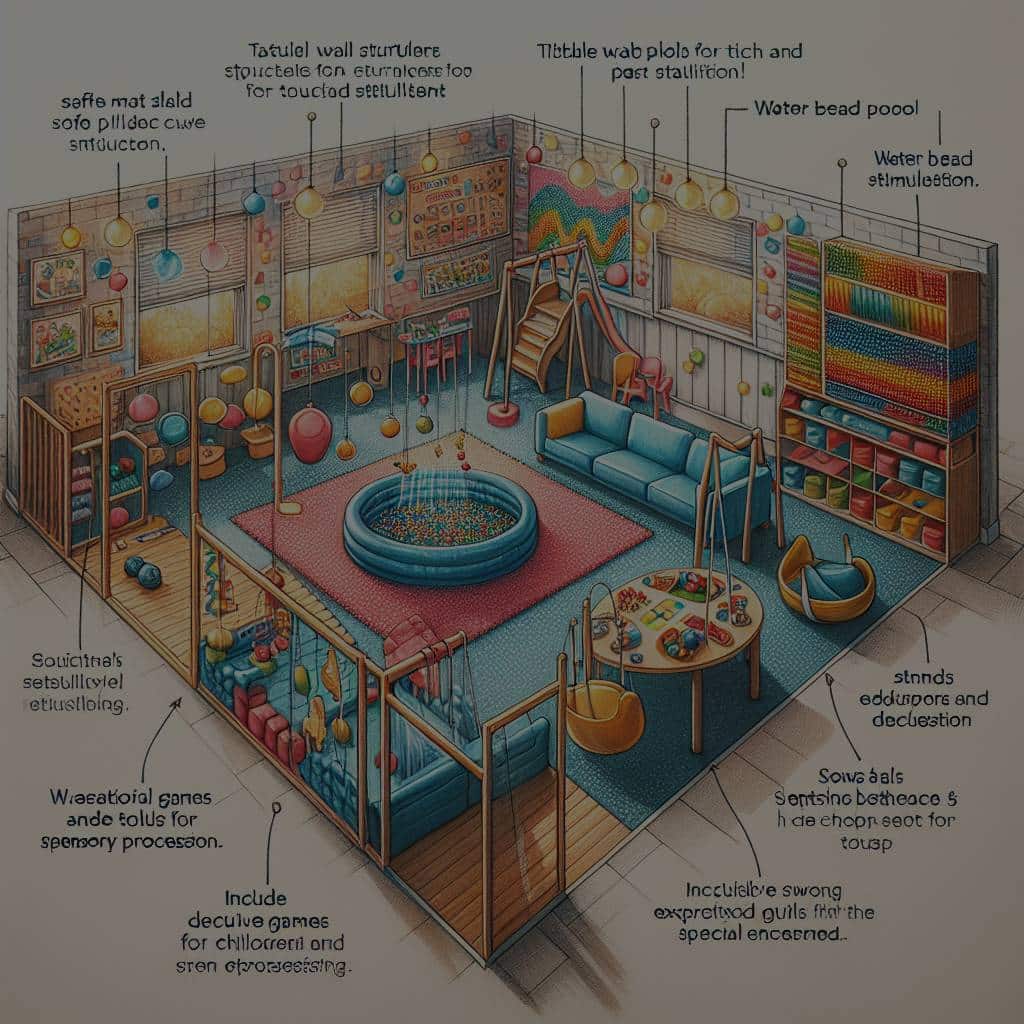How to Create a Multi-Sensory Playroom for Children with Special Needs?

Creating a multi-sensory playroom for children with special needs can be a game-changer. It not only brings joy to the child but can also be therapeutic. This kind of environment presents an opportunity for children to learn and grow while they play. It can help children with autism, sensory processing disorders, and other special needs to develop their sensory skills and adapt more easily to their world. If you’re keen on creating a multi-sensory room for your child, we’ve got some insights that’ll help you create a space that will meet their needs and provide them with a nurturing environment.
Understanding the Needs of the Child
Before you begin to design the room, it’s important to understand your child’s unique needs. Every child is different, and what works for one might not work for another. A thorough assessment of your child’s sensory preferences, learning needs, and developmental capabilities will help you plan a room that aligns with their individual needs.
In parallel : How Can You Use Smart Lighting to Enhance a Home Art Gallery?
One method of understanding a child’s needs is to observe their behavior in different situations. Watch how they respond to different stimuli. Do they enjoy certain textures? Are they calmed by specific sounds or colors? This information will help you incorporate elements they will enjoy and benefit from into the room.
A professional, such as an occupational therapist, can also provide valuable input. They can conduct a sensory profile of your child, identifying their sensory strengths and areas of need. Equipped with this knowledge, you’ll be able to create a room that caters to your child’s unique needs.
Also to read : What’s the Most Efficient Way to Organize a Spice Rack in a Narrow Pantry?
Planning the Sensory Room
Once you’ve gathered information about your child’s needs, you can begin the planning process. Consider the space you have available for the sensory room. It doesn’t need to be a large area; even a small corner of a room can be transformed into a calming and sensory-rich environment.
Take into account the different types of sensory input: visual, auditory, tactile, olfactory, and gustatory. Your child’s sensory profile will guide which types of input to focus on most. For example, a child with autism may benefit from visual and tactile stimuli, while a child with sensory processing disorder might need more auditory input.
Ensure the room is safe and comfortable for your child. Non-slip flooring, rounded edges on furniture, and secured equipment are essential. Choose calming colors for the walls, and consider installing dimmable lights if your child is sensitive to bright light.
Selecting the Right Equipment
The equipment you choose should match your child’s preferences and needs. A wide range of sensory equipment is available, from simple textured toys to high-tech interactive panels. Some of the items you might consider include:
- Tactile objects: These can range from soft toys to textured wall panels. They help children explore different textures and improve their tactile skills.
- Visual stimuli: Fairy lights, lava lamps, and bubble tubes create a visually stimulating environment.
- Auditory equipment: Sound machines that produce calming sounds such as waves or rain can help soothe an agitated child.
- Vestibular equipment: Swing sets, trampolines, and balance beams can help children improve their balance and spatial orientation.
Remember, the quality of items is more important than quantity. Too many items can overwhelm a child with sensory processing issues. Start with a few pieces and add more over time as your child becomes more comfortable in the space.
Incorporating Learning Activities
A multi-sensory room is not just about play. It’s also a space where children can learn and develop important skills. Incorporate activities that promote learning and development. For instance, a sand and water table can help develop fine motor skills, while puzzles and shape sorters can enhance cognitive abilities.
For children with autism, you can incorporate activities that help them understand and express emotions. Puppets, emotion cards, and interactive games can all be useful tools for this.
Keep in mind, the activities should be enjoyable for the child. Learning through play is the most effective way for children to learn, especially for those with special needs.
Creating a Calming Space
For students who may be overwhelmed by sensory input, it’s essential to create a calming space within the room. This area should be designed to provide a sense of security and tranquility. Soft cushions, bean bags, and weighted blankets can offer a comforting tactile input. A small tent or canopy can provide a sense of enclosure and safety.
Visual and auditory elements can also contribute to a calming atmosphere. Soft lighting, calming colors, and quiet, soothing sounds can help reduce stress and anxiety. For some children, a white noise machine or soft instrumental music can be helpful.
Remember, creating a multi-sensory room is not a one-size-fits-all approach. It requires careful consideration of your child’s needs, preferences, and abilities. But with thoughtful planning and implementation, you can create a space that not only supports your child’s sensory and learning needs but also provides a place of joy and fascination.
Maintaining the Sensory Room
A sensory room is not a one-and-done project. It requires regular maintenance to keep it clean, safe, and conducive to your child’s growth. Regularly inspect the room for any damages or potential hazards. Broken toys or equipment should be repaired or replaced immediately.
Cleaning the sensory room is not just about hygiene. Children with special needs may have allergies or respiratory conditions, and dust or mold can exacerbate these conditions. Regularly vacuum the room and clean all surfaces with child-friendly cleaning products. Don’t forget to wash soft toys and other items that can harbor dust mites.
If your child’s preferences or needs change over time, be open to adjusting the room accordingly. With growing age, their sensory needs might evolve, requiring different types of stimuli. Additionally, their interests might shift as they develop new skills and abilities. In these situations, some equipment might need to be swapped out for more age-appropriate or interest-aligned items.
Moreover, as they interact with the sensory room, they may develop new preferences or dislikes. Monitoring their interaction with the room can provide valuable insights into these changes. If you notice your child avoiding certain areas or becoming distressed with certain stimuli, it may be time to modify these elements.
Conclusion
Creating a multi-sensory room for a child with special needs requires a good understanding of their unique sensory needs and preferences. It’s a thoughtful blend of therapy and play, carefully designed to support the child’s development. A well-planned sensory room can significantly enhance a child’s sensory integration, motor skills, and cognitive abilities.
Remember, the sensory room should be an ever-evolving space that grows with your child. It should be periodically updated and maintained to ensure it continues to meet their changing needs. Incorporating their feedback and observations will help keep the room engaging and beneficial.
Whether it’s the calming bubble tubes, the textured wall panels, or the soothing sounds of a white noise machine, every element in the sensory room plays a crucial role in nurturing your child’s development. It’s a labor of love that can make a significant difference in the life of a child with special needs.
Ultimately, the goal is to create a safe and enjoyable space where your child can explore, learn, and grow at their own pace. The joy and progress you’ll witness in your child will make all the hard work worthwhile. After all, every child, with or without special needs, deserves a space where they can be themselves, have fun, and thrive.
